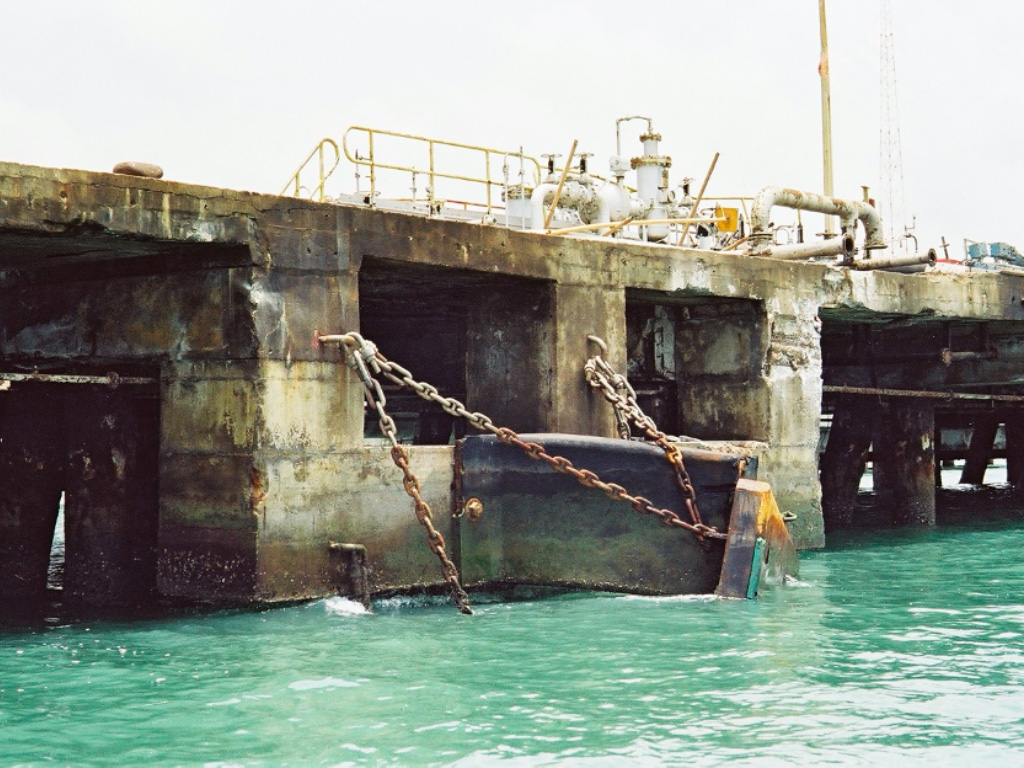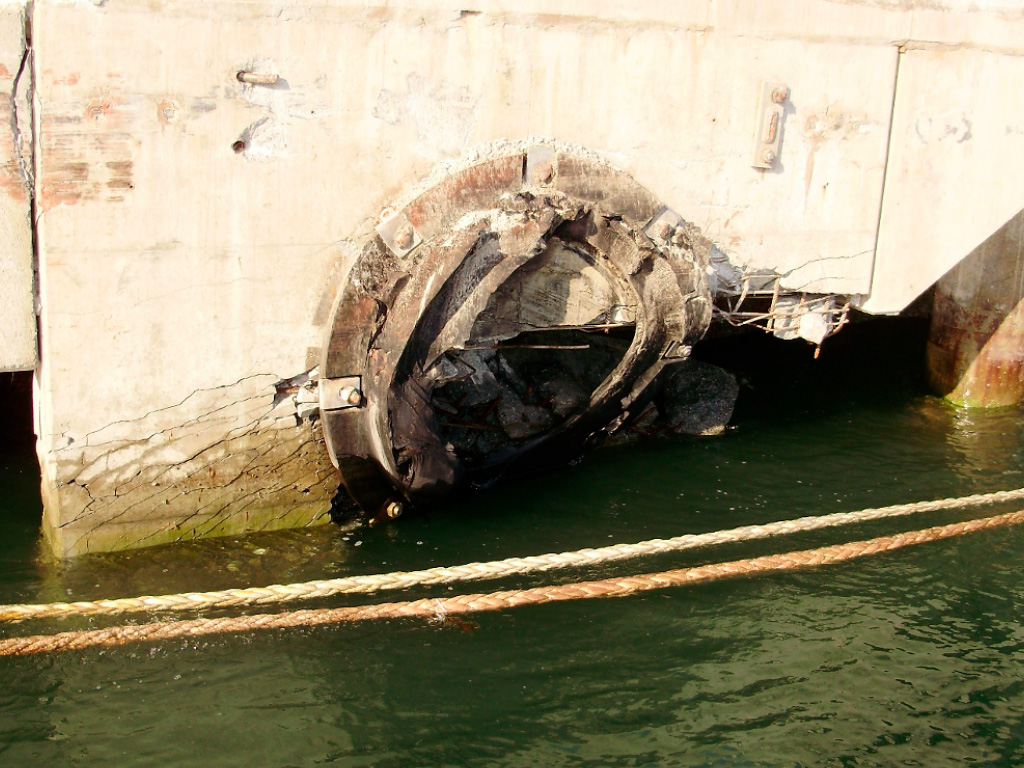EXPERT WITNESS
Why and How Fenders get Damaged or Fail
Ship2Shore are frequently called upon to assess damaged fenders resulting from a heavy collision. We also assist clients in testing existing fenders and analysing their performance. Here we set out typical modes of fender failure and its causation.
Fendering is generally damaged as the result of a heavy berthing, or from vessel impact with the fender’s supporting structure. The excessive compressive deflection of the rubber element can cause a fender and or its supporting structure to fail.
However, there are other situations that can cause a fender to fail and on occasions fenders are damaged by vessels ranging along the berth as a result of bad weather. If a vessel is moored tightly against a UHME-PE faced fender panel, the vertical movement of the vessel without the mooring lines being adjusted adequately, will result in dragging the vessel hard against the fender panel, eventually locking the panel to the hull. Any further downward movement of the vessel will result in breakage of chain anchors, chains or brackets and finally the rubber element.
Similarly, horizontal movement caused by catching a hull projection on a lateral fender edge. Again, movement of the vessel may result in breakage of chain anchors, chains or brackets and finally the rubber element.
The hysteresis inherent in all rubber products generates heat with each deflection. The amount varies with the deflection rate, the rubber compound and the shape of the reaction vs. deflection curve. This is primarily a concern where berths are exposed to continuous swells that are more or less perpendicular to the berth face. The continuous, cyclic deflections cause a gradual heating of the fender body to the point of internal, structural failure. This problem increases dramatically as fender dimensions increase and is most common in exposed berths.
The performance and useful life potential of a rubber fender is controlled by its chemistry. Aging and ozone resistance of the rubber, from which fenders elements are moulded, are two of the most important criteria that determine its performance useful life potential. However, most fender specifications do not specify rubber ozone resistance or will specify an acceptable aging resistance that is considerably lower than it could be for a slightly higher cost.

Points to consider in a fender damage claim
A common focus after any berthing incident is whether the fenders were safe and fit for their intended purpose at the time of the incident.
After an incident the immediate questions to ask include:
- What were the ship dynamics? Heading, course and speed over ground as well as draft, displacement, tide level and under keel clearance should all be logged and the data to substantiate this safely preserved.
- Were these parameters within the required operating limits for the berth?
- Did the fender(s) have sufficient absorption capacity?
- Were the fenders and their supporting structure well maintained and in a good state of repair? A useful benchmark is the condition of adjacent fenders. Photographs showing variations in fender condition can be invaluable.
Prompt action to preserve data and information is paramount. VDR data should be saved – it can be used to demonstrate the speed and characteristics of the ship during the berthing manoeuvre.
Steel and rubber samples can be taken to test the material grades and to compare rubber-degrading effects to build a fuller picture.
Prior damage is a key pointer to plausible causes or contributors. Are nearby fenders sagging and drooping? Is paint flaking off the steelwork or are there obvious signs of advanced corrosion? Are chains and connecting bolts all intact and in good condition, or are they slack, broken, pulling out or missing?
Important evidence can be lost in the hours and days after a berthing incident.

Cost Mitigation
The service life of a marine fender is usually twenty to twenty-five years depending upon its specification and the environment it operates in. During this time the fender should undergo regular annual inspection and interim maintenance every four to six years, although chains should be maintained more frequently. Unless regular inspections and maintenance routines are followed the service life of the fender will be shortened and due consideration needs to be included when a damaged fender is replaced, and a cost adjustment is proposed for betterment.
It is also not uncommon, in addition to normal wear and tear, for fenders to have previous unrepaired damage making the fender and its supporting structure vulnerable to further damage. The presence of this prior damage may be obscured by the new contact damage and care needs to be taken in these claims to ensure that the claim is appropriate to the force of impact and that due regard for the betterment is made.
Damage to the rubber elastomeric (and perhaps other proprietary) parts of fenders and their internal or outer connections to supporting structures often cannot be simply repaired and replacement may be the only reasonable option.
New fender units are in general made to order and can have long lead times. These can lead to delays to the repairs and may contribute to extended business interruption or consequential losses if the berth has been shut or significantly restricted in its operation due to the fender damage. Occasionally the owners/operators of the facility may have spare fender parts or units in store for an ongoing maintenance programme, which can enable repairs to be swiftly undertaken.
Temporary repairs, in the form of large tyres, or Yokohama type fenders can sometimes be employed whilst new fenders are on order, although these may alter the nature of the berthing forces being transferred to the berthing dolphin or quay wall, which could possibly lead to damage of these structures.
Replacing damaged fenders with secondhand items is a consideration but is not always possible as fenders are normally taken out of service or replaced only when they are damaged and no longer fit for purpose, so serviceable second-hand fenders are extremely rare.
Where the damaged fenders are near the end of their service life it may not be possible to provide identical new fenders to replace those damaged, as they may no longer be in production.
Replacing a particular manufacturer’s fender with a similar unit from another company may involve additional work and alteration to the supporting structure (quay wall or dolphin) to allow installation of the new unit, as the fenders may have different bolting patterns.

